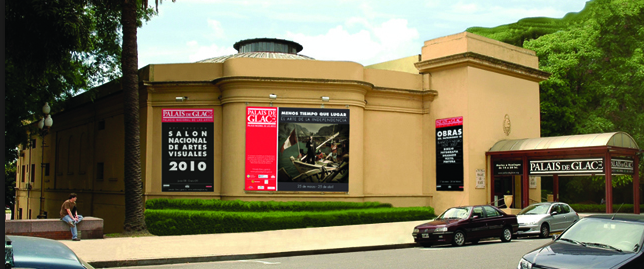Buenos Aires at Night
Concerts, festivals, theater, cinema, cafés. Milonga and tango houses. Pubs, discos and Bowling. Night activities in Buenos Aires are long lasting.
As of 7 pm (in winter, it’s already dark at that time; in summer, the sun is beginning to set) you may start to live the porteños’ night – which ends when the day breaks.
Before or after dinner?
Although it is not habitual to dine before 9 pm, the city’s offer is prepared for all tastes, predilections and budgets.
Those who prefer to eat earlier and then listen to music, go to the theater or do some shopping may choose a pub in the downtown area or Recoleta, a food court in one of the shopping malls – which are open during the mall hours – or a restaurant.
But also, you may eat – even from Monday through Friday – until after 1 am when some theater end their performances and the last movie screening (trasnoche) is about to begin.

DISCOS
Discos, discotheques or dancing clubs open at midnight and close between 6 and 7 am (some of these places extend the party until midday). It is quite common for young people to go to more than one place in the same night and have breakfast before going to bed.
For those unfamiliar with the “movida” porteña, an important tip is that everything starts very late. People usually go to dance at 2:30 am. The city has discos offering music to meet the tastes of all youngsters: dance and techno music, music from the 1980’s, 1960’s, salsa, Brazilian. There are also bailantas, playing a music style originated in the interior of the country (more precisely in the province of Córdoba), where live shows with popular bands are offered until the first rays of the sun bathe the city.
PEñAS
The folklore has a strong presence in the cultural activity of the city through the peñas criollas. All peñas offer musical shows, dance floor, typical food and drinks, and dance classes. In addition, also truco (a card game) competitions are organized. Many peñas have a definite musical identity – they specialize in melodies typical of different Argentine regions. Abasto, San Telmo and Palermo are neighborhoods where you will find most of them.
Zamba, chacarera, baguala, huayco:
Argentina is a country with different identities and cultural traditions. Distinct musical styles and dances characterize each region, and all these constitute the national folklore. Thus, the chamamé, the zamba and the chacarera, the baguala or the huayco are played and danced according to the usages of each region.

JAZZ
Buenos Aires has places exclusively devoted to jazz. Programs are varied – it’s better to consult the agenda – and offer all styles: from hot jazz to the most modern expressions.
Local artists such as Oscar Alemán, Mono Villegas, Gato Barbieri, Roberto Fats Fernández, Hugo Pierre, Jorge Navarro and Gustavo Bergalli, among others, gave jazz a prominent status in Buenos Aires. And, in many cases, they created new textures and sounds through fusions with the tango and the music of the Río de la Plata.
NOTABLE BARS
Traditional, alternative, outstanding, entertainment, sports, literary bars. The bar is the perfect place to read, talk with friends, navigate the Internet, see fashion shows, buy handicrafts, listen to livemusic, watch TV. It is also a typical place to discuss on politics, cinema, literature, soccer.
Among the oldest bars, you may find Tortoni and 36 Billares in Avenida de Mayo; La Giralda and La Paz in Avenida Corrientes; the Británico bar in Parque Lezama; Las Violetas in the corner of Medrano and Rivadavia; La Biela in Recoleta neighborhood and La Academia in the corner of Callao and Corrientes.
Some bars were officially declared as part of the cultural heritage of the City. Outstanding sites are those bars, billiards rooms and confiterías related to meaningful cultural events or activities, and also those that have a particular value due to their age, architectural design or local relevance.
The bar of famous people: Quinquela Martín, Juan de Dios Filiberto, Alfonsina Storni, Carlos Gardel, Federico García Lorca, Luigi Pirandello, Nalé Roxlo and Xul Solar were some of the habitual visitors of Café Tortoni on Avenida de Mayo 825/29.
Tango Milongas
Traditional milongas -dance nights which at best combine the neighbourliness of a social club with the faded elegance of a 1930s ballroom- mostly attract an older generation who prefer to dance al suelo; that is, feet pegged to the floor, legs discreetly doing triks as couples shuffle through steps called backward-eights, little sandwiches and sit-downs with ghostly subtlety.
Night Tours
The best Bars and Discos in town. We offer you a V.I.P. treatment in charge of the best Public Relations, in order to bring you a unique experience. Feel the real “night porteña” in a tour created by and for young people. Join the ride, give us a night of your life.
Gays & Lesbians
Full list of Gay’s Night Clubs in Buenos Aires.



 Make this Valentine's day unforgettable! Celebrate it in Buenos Aires! Make this gift to your loved one. Find
Make this Valentine's day unforgettable! Celebrate it in Buenos Aires! Make this gift to your loved one. Find